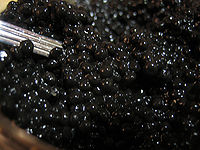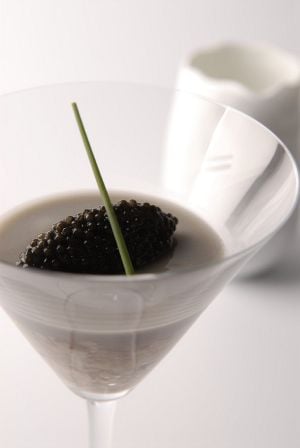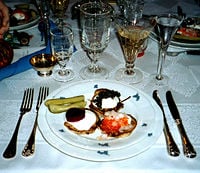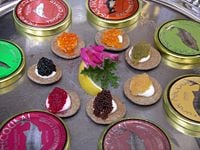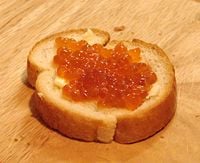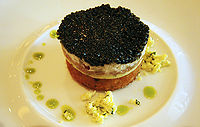Caviar
Caviar is the processed, salted roe of certain species of fish, most notably the sturgeon. It is commercially marketed worldwide as a delicacy and is eaten as a garnish or a spread; for example, with hors d'œuvres. It is synonymous with luxury—historically the favorite of the elite, and today highly priced due to the short supply of sturgeon.
Preparation
Caviar is the roe or eggs taken from freshly caught fish, sturgeon for true caviar, and passed through a fine mesh in order to remove fatty tissue and membrane. The eggs are lightly salted to bring out the flavor and also to preserve the eggs. The highest quality caviar are from beluga, ossetra, and sevruga sturgeon.
Caviar may also be made from other fish, such as salmon, lumpfish, and whitefish. The salmon roe are red, while the roe of lumpfish may be died black to resemble sturgeon eggs.
The Russian word malossol ("little salt") is used to show that the caviar is minimally salted; typically, caviar is four to eight percent salt. Less salt means the roe was of higher quality, and thus more expensive. However, it is also more perishable.
History
The word caviar is ultimately derived from Persian khavyar, from khaya meaning "egg." The word first appeared in English print in 1591.[1] In Persian, the word refers to both the sturgeon and its roe.
Use
Cultural significance
Given its high price in the West, caviar is synonymous with luxury and wealth. In Russia and other Eastern European cultures, though still expensive, caviar is commonly served at holiday feasts, weddings, and other festive occasions. Sturgeon-derived caviar is generally not eaten by Jews who keep kosher, because sturgeon lacks scales and thus is not considered kosher; however, this does not apply to every roe-yielding fish species. In Islam all sea or river animals such as fish are lawful and halal which applies to the sturgeon as well as its caviar (depending on which school of practice). In Hong Kong and Japan, caviar may be found on sushi and is often very affordable.
Varieties
The Caspian Sea is considered the source of the finest caviar in the world. Contemporary black caviar is roe from sturgeon fished from the Caspian Sea by Azerbaijan, Iran, Russia, and Kazakhstan.
The harvest and sale of black caviar was banned in Russia since August 1, 2007. The ban extends for ten years, but scientific research and the artificial breeding of black caviar fish are exempted. The golden Sterlet caviar, the rarest of caviars, was the favorite of czars, shahs, and emperors.
Due to cost and problems with the dwindling supply of sturgeon, alternative forms of "caviar" are commonly prepared from salmon, producing red caviar, lumpfish, and whitefish. Today, the highest prices are paid for the Beluga, Ossetra, and Sevruga sturgeon varieties of caviar.
Beluga
Beluga caviar (branded as Almas caviar in Iran meaning 'Diamond caviar') consists of the roe (or eggs) of the Beluga sturgeon found primarily in the Caspian Sea. It can also be found in the Black Sea basin and occasionally in the Adriatic Sea. This fish is currently considered to be endangered, causing the United States Fish and Wildlife Service to ban the importation of Beluga caviar which originated in the Black Sea basin. Beluga is also the most expensive of caviars. In January 2007, this ban was partly lifted, allowing the sale of 96 tons of caviar, 15 per cent below the official 2005 level.[2]
The Beluga sturgeon can take up to 20 years to reach maturity. The fish harvested for caviar are often nearly 2000 pounds. The eggs themselves are the largest of the commonly used roes, and range in colour from light blue to black, with the lighter colours coming from older fish, and being the highest valued. Any additions by producers diminish the value of the roe, and the caviar usually reaches the market without any additions or processing whatsoever. Most people also find a good bit of acidity and/or sweetness in the flavour as well.
As with most caviars, Beluga is usually handled with a spoon made of mother of pearl, bone, or other non-metallic material, as metal utensils tend to impart an unwelcome metallic taste to the delicate and expensive roe. But Beluga caviar, unlike less expensive varieties is usually served by itself on toast whereas other caviars can be served in a variety of ways, including hollowed and cooked new potatoes, on a blini, or garnished with sour cream, crème fraîche, minced onion or minced hard boiled egg whites. The higher grade caviars, including Beluga, usually need very little embellishment.
Beluga caviar ranges in price from more than $5,000 per kilogram in the United States, to a low of around $250 per kilo in Atyrau, Kazakhstan, the major production center.
Ossetra
Ossetra (Osetra or Asetra) caviar comes from the Ossetra sturgeon (Acipenser gueldenstaedtii), weighing 50-400 pounds and living up to 50 years. Ossetra caviar ranges from warm brown to green-gray in color, to dark blue to jet black or even white. Ossetra caviar is said to have a nutty flavour and so is prized as an elite caviar.
The Ossetra sturgeon is slightly smaller than the Beluga sturgeon (Huso huso). As caviar, it is of firmer texture than the more delicate Beluga caviar. Golden Ossetra is a rare form of Ossetra caviar, and is golden-yellow in color. It has a very rich flavor.
As with other caviars, ossetra is traditionally served on buttered toast points with fresh, minced onion. It also is served on blinis, and sometimes cream cheese or sour cream accompanies the caviar on crackers. The lower-graded varieties of caviar are used as stuffings in many seafood dishes and for some meat dishes. Caviar can and is often found in salads as well.
Sevruga
Sevruga is one of the highest priced varieties of caviar, eclipsed in cost only by the Beluga and Ossetra varieties. It is harvested from the Sevruga sturgeon native to the Caspian Sea, and may be distinguished from its more expensive cousins by the size of the eggs, which are generally smaller.
Issues
In the early 1900s, Canada and the United States were the major caviar suppliers to Europe; they harvested roe from the lake sturgeon in the North American midwest, and from the Shortnose sturgeon and the Atlantic sturgeon spawning in the rivers of the Eastern coast of the United States. Today, however, the Shortnose sturgeon is rated Vulnerable in the IUCN Red List of endangered species and rated Endangered per the U.S. Endangered Species Act.
In Spain a fish farm called Caviar de Riofrio has begun to produce organic caviar. The company raises sturgeon in such a way that it has earned organic certification by CITES.[3]
Current aquaculture of sturgeon is an economically viable means of sustainable, commercial caviar production, especially in Spain, France, Uruguay, and California.[4] Hackleback caviar is a popular, inexpensive product of this industry. Paddlefish, a sturgeon cousin, is also farmed in increasing numbers.
Recently, the amount of allowed wild fish harvesting has been decreased, consequently increasing caviar prices. In September 2005, the United States Fish and Wildlife Service banned the import of Caspian Sea Beluga caviar, to protect the endangered Beluga sturgeon; a month later, the ban included Beluga caviar from the entire Black Sea basin. In January 2006, CITES, the convention for trade in endangered species, announced they were "unable to approve the [caviar] export quotas" for 2006 from wild fish stocks.[5] In January 2007, this ban was partly lifted, allowing the sale of 96 tons of caviar, 15% below the official 2005 level.[6]
Alternatives and imitation
The dwindling fishing yields consequent to overfishing and pollution have resulted in the creation of less costly, though popular, caviar-quality roe alternatives from the whitefish and the North Atlantic salmon.
In Scandinavia, a significantly cheaper version of caviar, made from mashed and smoked cod roe, is sold in tubes as a sandwich filling. When sold outside Scandinavia, the product is referred to as creamed smoked roe.
An obvious sturgeon caviar imitation is Danish black coloured lumpsucker caviar, which is sold throughout Europe in small glass jars. It can also be found red coloured. A more expensive sturgeon caviar alternative, sold in Sweden and Finland, is the caviar from the vendace. In Finland caviars from the burbot and the common whitefish are also sold.
In the vegetarian foodstuffs market, Algae-based imitation caviar is produced and sold as a caviar alternative.
Notes
- ↑ Peggy Trowbridge Filippone Caviar history About.com, 2008. Retrieved September 11, 2008.
- ↑ UN lifts embargo on caviar trade BBC News, Tuesday, 2 January 2007. Retrieved September 11, 2008.
- ↑ www.boston.com - More than one fish egg in the sea
- ↑ California Farm Bureau Federation - Farmers tame prehistoric fish to make food fit for a king
- ↑ news.bbc.co.uk - International caviar trade banned
- ↑ news.bbc.co.uk - UN lifts embargo on caviar trade
ReferencesISBN links support NWE through referral fees
- Boeckmann, Susie, and Natalie Rebeiz-Nielsen. Caviar: The Definitive Guide. Wiley, 2000. ISBN 978-0470392997
- Carey, Richard Adams. The Philosopher Fish: Sturgeon, Caviar, and the Geography of Desire. Counterpoint, 2006. ISBN 978-1582433523
- Inman, Mason. Once Endangered Sturgeon Rebounding in Hudson River, Study Says National Geographic News, February 7, 2007. Retrieved July 3, 2008.
- Javadi, Masoud, and Nasser Sagheb Caspian caviar in peril Azerbaijan International 2.3 (Autumn 1994): 50-52. Retrieved July 3, 2008.
- Le Goff, Olivier. The World of Caviar. Chartwell Books, 1999. ISBN 978-0785810841
- Morris, Jim. Dinosaur in the Delta: Farmers tame prehistoric fish to make food fit for a king California Farm Bureau Federation, August 3, 2005. Retrieved July 3, 2008.
- Saffron, Inga. Caviar: The Strange History and Uncertain Future of the World's Most Coveted Delicacy. New York, NY: Broadway Books, 2003. ISBN 978-0767906241
- Swengel, Andrea Lynn. Discovering Caviar . Campbell & Lewis Publishers, 2008. ISBN 978-0977148974
External links
- Caviar Cooking For Engineers
- American Caviar - Think American Caviar!
- History Russian Caviar, 2000. Retrieved September 2, 2008.
Credits
New World Encyclopedia writers and editors rewrote and completed the Wikipedia article in accordance with New World Encyclopedia standards. This article abides by terms of the Creative Commons CC-by-sa 3.0 License (CC-by-sa), which may be used and disseminated with proper attribution. Credit is due under the terms of this license that can reference both the New World Encyclopedia contributors and the selfless volunteer contributors of the Wikimedia Foundation. To cite this article click here for a list of acceptable citing formats.The history of earlier contributions by wikipedians is accessible to researchers here:
The history of this article since it was imported to New World Encyclopedia:
Note: Some restrictions may apply to use of individual images which are separately licensed.
